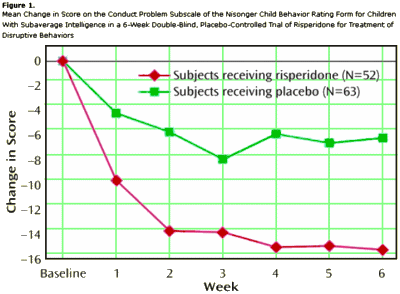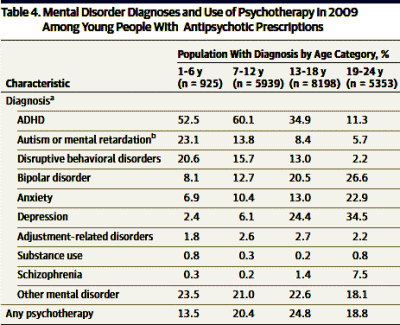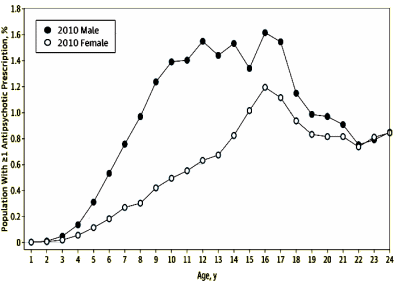When Risperdal® [Risperidone] came along in 1994, it was widely hoped [and hyped] that it would release patients from the heavy and sometimes dangerous side effect burden of the earlier neuroleptic medications. One of Janssen’s targeted indications was in to control disruptive behaviors in intellectually impaired children. This RCT was completed in 1998, and used in a submission to the FDA…
by Michael G. Aman, Ph.D., Goedele De Smedt, M.D., Albert Derivan, M.D., Ben Lyons, Ph.D., Robert L. Findling, M.D., and the Risperidone Disruptive Behavior Study GroupAmerican Journal of Psychiatry 2002 159:1337-1346.[ClinicalTrials.gov Identifier: NCT00266552]
Objective: The short-term efficacy and safety of risperidone in the treatment of disruptive behaviors was examined in a well-characterized cohort of children with subaverage intelligence.Method: In this 6-week, multicenter, double-blind, parallel-group study of 118 children [aged 5-12 years] with severely disruptive behaviors and subaverage in- telligence [IQ between 36 and 84, inclusive], the subjects received 0.02-0.06 mg/kg per day of risperidone oral solution or placebo. The a priori primary efficacy measure was the change in score from baseline to endpoint on the conduct problem subscalc of the Nisonger Child Behavior Rating Form.Results: The risperidone group showed significantly greater improvement than did the placebo group on the conduct problem subscale of the Nisonger Child Behavior Rating Form from week 1 through endpoint [change in score of -15.2 and -6.2, respectively]. Risperidone was also associated with significantly greater improvement than placebo on all other Nisonger Child Behavior Rating Form subscales at endpoinl. as well as on the Aberrant Behavior Checklist subscales for irritability, lethargy-social withdrawal, and hyperactivity; the Behavior Problems Inventory aggressive -destructive behavior subscale; a visual analogue scale of the most troublesome symptom; and the Clinical Global Impression change score. The most common adverse effects reported during risperidone treatment were headache and somnolence. The extrapyramidal symptom profile of risperidone was comparable to that of placebo. Mean weight increases of 2.2 kg. and 0.9 kg occurred in the risperidone and placebo groups, respectively.Conclusions: Risperidone was effective and well tolerated for the treatment of severely disruptive behaviors in children with subaverage IQ.
… that was denied, not because of lack of efficacy, but because the FDA felt the indication was too broad and might lead to the overmedication of kids. This Janssen study was repurposed, rewritten [ghost written], and republished under Dr. Joseph Biederman’s name in 2006 as part of his series on the treatment of the Bipolar Child [bipolar kids: biedermania and super angry/grouchy/cranky irritability…]. Janssen was later fined for off-label promotion and other forbidden marketing practices.
In the intervening decades, the Atypical Antipsychotics haven’t lived up to those early expectations, at least in a medical sense. But they became blockbusters at the marketplace – one or another of them dominating the sales charts for years. While the side effect profiles differ from those of the first generation drugs, they are hardly benign. And the feared overmedication of children moved out of the domain of future worry into our current reality. This next article by Olfson et al is a new population survey of antipsychotic medication use in youth that aims to flesh out that current reality [the reason I started with Aman et al’s early trial will become obvious]:
by Mark Olfson, MD, MPH; Marissa King, PhD; Michael Schoenbaum, PhDJAMA Psychiatry. online July 01, 2015. doi:10.1001/jamapsychiatry.2015.0500.
Importance Despite concerns about rising treatment of young people with antipsychotic medications, little is known about trends and patterns of their use in the United States.Objective To describe antipsychotic prescription patterns among young people in the United States, focusing on age and sex.Design, Setting, and Participants A retrospective descriptive analysis of antipsychotic prescriptions among patients aged 1 to 24 years was performed with data from calendar years 2006 [n = 765,829], 2008 [n = 858,216], and 2010 [n = 851,874], including a subset from calendar year 2009 with service claims data [n = 53,896]. Data were retrieved from the IMS LifeLink LRx Longitudinal Prescription database, which includes approximately 60% of all retail pharmacies in the United States. Denominators were adjusted to generalize estimates to the US population.Main Outcomes and Measures The percentage of young people filling 1 or more antipsychotic prescriptions during the study year by sex and age group [younger children, 1-6 years; older children, 7-12 years; adolescents, 13-18 years; and young adults, 19-24 years] was calculated. Among young people with antipsychotic use, percentages with specific clinical psychiatric diagnoses and 1 or more antipsychotic prescriptions from a psychiatrist and from a child and adolescent psychiatrist were also determined.Results The percentages of young people using antipsychotics in 2006 and 2010, respectively, were 0.14% and 0.11% for younger children, 0.85% and 0.80% for older children, 1.10% and 1.19% for adolescents, and 0.69% and 0.84% for young adults. In 2010, males were more likely than females to use antipsychotics, especially during childhood and adolescence: 0.16% vs 0.06% for younger children, 1.20% vs 0.44% for older children, 1.42% vs 0.95% for adolescents, and 0.88% vs 0.81% for young adults. Among young people treated with antipsychotics in 2010, receiving a prescription from a psychiatrist was less common among younger children [57.9%] than among other age groups [range, 70.4%-77.9%]. Approximately 29.3% of younger children treated with antipsychotics in 2010 received 1 or more antipsychotic prescriptions from a child and adolescent psychiatrist. Among young people with claims for mental disorders in 2009 who were treated with antipsychotics, the most common diagnoses were attention-deficit/hyperactivity disorder in younger children [52.5%], older children [60.1%], and adolescents [34.9%] and depression in young adults [34.5%].Conclusions and Relevance Antipsychotic use increased from 2006 to 2010 for adolescents and young adults but not for children aged 12 years or younger. Peak antipsychotic use in adolescence, especially among boys, and clinical diagnosis patterns are consistent with management of developmentally limited impulsive and aggressive behaviors rather than psychotic symptoms.
I’ve spent a couple of days reading over this article and its companion editorial. I suppose I wanted to find something profound to say about it, or maybe decry what it has to say in some new way, or even find some new target to blame. But I can’t beat the authors’ conclusion:
Peak antipsychotic use in adolescence, especially among boys, and clinical diagnosis patterns are consistent with management of developmentally limited impulsive and aggressive behaviors rather than psychotic symptoms.
In the text they go on to make recommendations:
Clinical policy makers have opportunities to promote improved quality and safety of antipsychotic medication use in young people through expanded use of quality measures, physician education, telephone- and Internet-based child and adolescent psychiatry consultation models, and improved access to alternative, evidence-based psychosocial treatments.
This paper documents a simple fact – what used to be called antipsychotic medication is being used as a behavior control aid in children and adolescents, much like Aman et al discussed using it in the earliest of days. The likelihood that these latter suggestions will be implemented or that they would make much difference if they were probably approximates zero without a palpable change in the current climate of child and adolescent psychiatry and its professional organizations…



“Define a fidget”—a skeptical Tony Soprano.
Disruptive is by definition biopsychosocial and not purely clinical. It means a behavior that isn’t bothering the patient is bothering someone else.
This is creeping into Soviet psychiatry territory here. I know this is about kids but this kind of thinking about meds is in general is Cuckoo’s Nest scary. Too bad the study wasn’t limited to violent acting out.
Well, at least it is not an epidemic… rates are generally well below 1.6% of the youth population (your Figure). The children who come to receive the antipsychotic drugs seem to have a good deal of co-morbidity (your Table) and concurrent use of other drugs (Table 3 of the article). No question, however, that few of these children have a formal psychotic disorder.
Without data on outcomes one can’t do much more than to sound cautions. I have no absolute objection to the judicious use of antipsychotic drugs in the management of youth who display severe and dangerous behavior disorders, but the current laissez faire system isn’t working for the children. Will the vaunted new electronic health records be put to use in tracking outcomes and toxicity and developmental course in all these children? Will they serve as a basis of quality assurance programs that have teeth? It is sad to note that our society permits commercialization of the data on prescriptions through IMS while it ignores systematic gathering of safety and benefit data.
I agree it’s not an epidemic, and that sometimes using these drugs is the right thing to do. But reading this study, I had the feeling that this was kind of routine. The thing I didn’t say because I couldn’t document it [but am still trying] is that people are being put in the position of only having the medication tool brcause of the evaporation of the services we used to count on in dealing with these behavioral symptoms. When they say, “improved access to alternative, evidence-based psychosocial treatments,” it implies that access is the problem. I think that it’s the existence of such programs offering those treatments where we need to look. ‘Slim Pickings’ out there these days…
This is a different view of this:
http://pediatrics.aappublications.org/content/early/2015/02/24/peds.2014-2260.abstract
a prescription from a psychiatrist was less common among younger children [57.9%] than among other age groups [range, 70.4%-77.9%]. Approximately 29.3% of younger children treated with antipsychotics in 2010 received 1 or more antipsychotic prescriptions from a child and adolescent psychiatrist.
Are these being prescribed by psychiatrists trained in adult psychiatry who never got child and adolescent training and have been found to be the only psychiatrists available? OR are a whole bunch of these drugs being prescribed by pediatricians and family practitioners? The latter is truly horrifying.
That didn’t let me blockquote the 1st paragraph, but that was a quote.
.
Ok. It worked. Sorry about that.
One issue is: Who are the prescribers? A friend is a pedi and hates the start of the school year. She receives notes from teachers and school administrators demanding kids be put on meds because, after of summer of play, they are expected to sit quietly and do their prescribed work.
With our school systems becoming more and more regulated and regimented meds become the way to keep Johnny, and it is usually Johnny, in his seat. Kids, being smarter than we give them credit for, are also using meds to enhance their study time.
This all ties into the narrative that meds are good, good for pharma, but creates a dependency on the part of children that they carry into adulthood.
Additionally some school systems use medication use as a means to enhance income by claiming these children all into the special needs category. We are watching our system move to one where we have to question the motives of those involved.
Steve Lucas
So… speaking as someone who actually *was* one of those children treated, I think your suspicions that this was routine are likely correct. It happened several years before the study period, and my experience is merely anecdotal, but if the way I was given Risperdal at around age 13 was at all typical, the medications were (and presumably still are) often used with far less pretext than even treating “developmentally limited impulsive and aggressive behaviors”. I’m guessing it’s worse than you think. One of these days I ought to get hold of my records and see what the specific rationale was, but afaict the justification was little more than “I have a patient, let’s just try different drugs until we find one that works.” I’d been given a couple different (very questionable) diagnoses, but I think an independent assessment would’ve judged me an intelligent kid and good student who was lonely and profoundly unhappy with school. Measures of comorbidity may be misleading here if the bar for diagnosis was as low for the study population as it was for me.
http://www.madinamerica.com/2015/07/rem-sleep-critical-for-childrens-learning-medications-can-disrupt/
Governments should protect children, young and old from being experimented with and taken advantage of by snake oil sellers aiming primarily for financial gain.
http://www.madinamerica.com/2015/07/always-a-mystery-why-do-drugs-come-and-go/
Dr Norman Hoffmann’s comment to this article is worth quoting: “I think an important aspect of this issue is that the widespread use of drugs, whether prescription or street drugs, is evidence of social dyspunction. One could say that governments and corporations prefer to encourage drug use…rather than have people vocalize social discontent. Our society has not shown the courage to attend to serious fundamental problems, and has allowed drug industries to flourish.” Amen.
There’s an apparent connection between stimulants and anti-psychotics for children diagnosed with ADHD. Riddle et al’s 6-year follow-up of the NIMH-funded Preschool Attention Deficit/Hyperactivity Disorder Treatment Study (PATS) published in JAAC&AP found that by year 3 (mean age now 7.2), an anti-psychotic had been added to 8.3% of the preschoolers’ medication regimen (and for 10.7%, a norepinephrine reuptake inhibitor), and by age 10, 12.9% were taking an antipsychotic (and for 8.6%, an SSRI). Olfson et al’s 2012 AGP article found that between 1993-1998 and 2005-2009, the rate of anti-psychotics prescribed to children increased by over 750% (mirroring a similar increase in the diagnosis & prescribing of stimulants for ADHD) and that whenever an anti-psychotic was prescribed, there was also an ADHD medication prescribed to the same child during the outpatient visit.
“I think that it’s the existence of such programs offering those treatments where we need to look. ‘Slim Pickings’ out there these days…”
Correct.
In addition, a lot of what I’ve seen is parents not wanting to participate in treatment. The majority of these disruptive kids have parents with their own psychopathology and/or poor parenting strategies and/or toxic family dynamics that perpetuate the situation. Even when effective psychosocial treatment is available, many parents decline for a number of reasons, sometimes justified, but many times, not.
Disruptive… hmm. Frankly, I suspect many of the kids weren’t disruptive at all. Table 4 suggests the antipsychotics were often used simply as psychiatric cure-alls, with the pills used for behavior issues in young kids and for mood problems in the older ones. We know Janssen illegally marketed Risperdal for off-label uses, so it’s no great stretch to suppose many kids were prescribed the stuff for even non-disruptive problems such as depression and anxiety, for example.